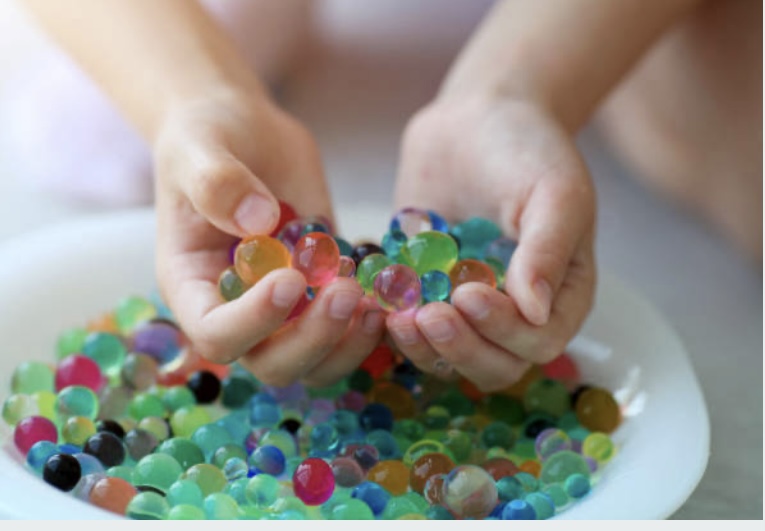Ever seen those tiny, hard pellets transform into sparkling, squishy spheres that seem to defy gravity? Welcome to the wonderful world of water beads! These mesmerizing little orbs have become a staple in sensory play, and for good reason. They offer a unique, calming, and endlessly engaging experience for children (and even adults!).
Let’s dive into everything you need to know about these fascinating sensory tools.
What Are Water Beads and How Do They Work?
At first glance, water beads look like tiny, hard plastic BBs. But don’t let their humble beginnings fool you! They are actually made from superabsorbent polymers, similar to those found in baby diapers. When introduced to water, these polymers act like tiny sponges, absorbing hundreds of times their weight in liquid.
The transformation process:
- Add Water: Place the dry beads in a large bowl or container.
- Watch Them Grow: Cover them generously with water.
- Wait: Over the next 4-8 hours (sometimes longer!), the beads will slowly expand, becoming larger, squishier, and beautifully translucent. They retain their vibrant colors, even as they grow!
Once fully hydrated, they’re ready for play!
The Amazing Sensory Benefits of Water Beads
Water beads are a goldmine for sensory exploration and development. Here’s why they’re so beneficial:
- Tactile Stimulation: This is their superstar quality! Their smooth, squishy, cool, and slippery texture provides a unique tactile experience that can be incredibly calming and grounding for many children. It’s a delightful sensation to run fingers through, scoop, and squeeze.
- Visual Engagement: The vibrant colors and translucent quality of water beads are visually captivating. Watching them roll, bounce, and shimmer can be mesmerizing, aiding in visual tracking and color recognition.
- Fine Motor Skills: Scooping, pouring, grasping, and manipulating the beads (especially with tools) helps develop hand-eye coordination, pincer grasp, and overall fine motor dexterity.
- Calming and Regulating: For children who benefit from deep pressure or soothing textures, water beads can be incredibly calming. The repetitive action of running hands through them can help regulate emotions and reduce anxiety.
- Language Development: As children play, they can describe what they feel, see, and do. “Squishy,” “slippery,” “cold,” “bouncy,” “smooth,” “colorful” – these are all words that naturally emerge during water bead play, building vocabulary.
- Cause and Effect: Observing the tiny beads grow into large ones teaches a clear lesson about cause and effect.
- Imaginative Play: Water beads can be easily incorporated into miniature worlds, sparking creativity and storytelling.
Safety First: A Crucial Note!
While water beads are fantastic for sensory play, it is paramount to prioritize safety, especially with younger children or those who mouth objects.
- Choking Hazard: Dry water beads are tiny and pose a severe choking hazard. Even hydrated beads can be a choking risk if not properly supervised.
- Expansion Hazard: The most critical warning: If ingested, water beads can continue to expand inside the body, potentially causing life-threatening bowel obstructions.Seek immediate medical attention if you suspect a child or pet has swallowed a water bead.
- Supervision is Key: Water beads are recommended for children ages 3 and up, ALWAYS with direct, active adult supervision. For younger children, consider alternative sensory materials.
- Keep Away from Pets: Pets can also be curious and might ingest them, leading to similar dangers.
- Disposal: Never flush water beads down the toilet or sink, as they can expand and clog pipes. Dispose of them in the trash.
Wonderful Ways to Play with Water Beads
Once hydrated and safety measures are in place, the possibilities are endless!
- Simple Exploration: The most basic and often the most satisfying! Let kids simply put their hands in a bin full of water beads, run their fingers through them, and feel the unique texture.
- Scooping and Pouring Station:Provide scoops, spoons, measuring cups, funnels, and empty containers. This is fantastic for developing fine motor skills and understanding volume.
- Sensory Bin Adventures:
- Add Animals: Small plastic animals (farm, ocean, jungle) turn the beads into an imaginative habitat.
- Underwater World: Add blue beads, shells, small plastic fish, and “seaweed” (green pipe cleaners).
- Garden Play: Combine green beads with small flowers, miniature gardening tools, and bugs.
- Construction Zone: Yellow or orange beads with toy construction vehicles.
- Light Table Fun: If you have a light table, place clear or lightly colored beads on it. The light shining through them creates a stunning, ethereal effect.
- Water Bead “Rescue”: Hide small, waterproof toys or coins within the beads and have children use tongs or their fingers to find and “rescue” them.
- Outdoor/Water Table Play: Take the fun outside! Water beads are great in a water table, where kids can add more water, experiment with floating objects, and enjoy the open-ended play.
Cleanup and Storage Tips
- Containment: Play in a shallow bin or tray to help contain the mess. Laying a towel underneath can catch stray beads.
- Storage: Store hydrated water beads in an airtight container (like a Ziploc bag or plastic tub) in the refrigerator. They can last for several weeks to a few months this way. If they start to shrink, just add a little more water to rehydrate them.
- Disposal: When play is done, roll them onto a towel to dry out or simply scoop them into the trash. Remember, never flush them!
If You Love Water Beads, You Might Also Like…
Looking for more sensory adventures? Here are some other materials that offer unique tactile experiences:
- Cooked Pasta/Noodles: Cooked al dente and cooled, these offer a soft, slippery, and sometimes chewy texture. You can even dye them with food coloring!
- Sensory Sand: Moldable, squishable, and effortlessly flows through fingers, offering a fantastic unique texture.
- Dyed Rice or Beans: Easy to make at home with food coloring and rubbing alcohol. Offers a great pouring and scooping experience.
- Cloud Dough: A simple mixture of flour and oil that’s soft, crumbly, and moldable.
- Slime or Putty: Offers a wide range of textures from stretchy to squishy to gooey.
- Water Play: The simplest and often most engaging sensory material there is! Add bubbles, scoops, and toys.
Water beads truly are a magical addition to any sensory play collection. With proper safety precautions and a little imagination, they can provide hours of calming, engaging, and developmentally enriching fun for your little ones. So go ahead, unlock the sensory wonder and watch the joy unfold!


